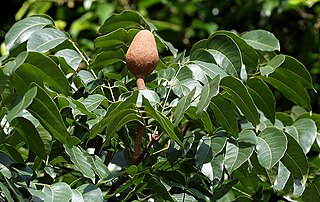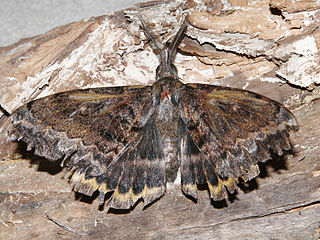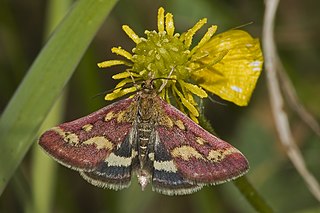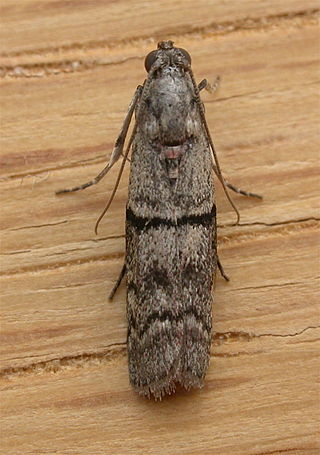
Lepidoptera or lepidopterans is an order of winged insects which includes butterflies and moths. About 180,000 species of the Lepidoptera have been described, representing 10% of the total described species of living organisms, making it the second largest insect order with 126 families and 46 superfamilies, and one of the most widespread and widely recognizable insect orders in the world.

Moths are a group of insects that includes all members of the order Lepidoptera that are not butterflies. They were previously classified as suborder Heterocera, but the group is paraphyletic with respect to butterflies and neither subordinate taxon is used in modern classifications. Moths make up the vast majority of the order. There are approximately 160,000 species of moth, many of which have yet to be described. Most species of moth are nocturnal, although there are also crepuscular and diurnal species.

The Pyraloidea are a moth superfamily containing about 16,000 described species worldwide, and probably at least as many more remain to be described. They are generally fairly small moths, and as such, they have been traditionally associated with the paraphyletic Microlepidoptera.

Swietenia is a genus of trees in the chinaberry family, Meliaceae. It occurs natively in the Neotropics, from southern Florida, the Caribbean, Mexico and Central America south to Bolivia. The genus is named for Dutch-Austrian physician Gerard van Swieten (1700–1772). The wood of Swietenia trees is known as mahogany.

Anthelidae is a family of Australian lappet moths in the order Lepidoptera. It had earlier been considered to be part of the Lasiocampoidea superfamily, but a 2008 molecular phylogenetic study, supported by a 2011 study, resulted in reincluding the Anthelidae in the superfamily Bombycoidea.

The Plutellidae are a family of moths commonly known as the diamondback moths, named after the diamondback moth of European origin. It was once considered to have three subfamilies: Plutellinae, Praydinae, and Scythropiinae. Praydinae was later elevated to its own family, Praydidae, while Scythropiinae has variously been moved to Yponomeutidae or also elevated to its own family.

Eupoecilia ambiguella, the vine moth or European grape berry moth, is a Palearctic moth species of the family Tortricidae. It was first described in 1796 by Jacob Hübner. It is an economically significant grape pest species.

The Obtectomera is a clade of macro-moths and butterflies, comprising over 100,000 species in at least 12 superfamilies.

Hypsipyla grandella is a moth of the family Pyralidae. It is found in southern Florida, most of the West Indies, Sinaloa and southward in Mexico, Central America, South America except Chile and in Mauritius.

Ectomyelois ceratoniae, the locust bean moth, more ambiguously known as "carob moth", is a moth of the family Pyralidae. It has a nearly cosmopolitan distribution.

The Phycitini are a tribe of moths of the family Pyralidae.

Hypsipyla is a genus of snout moths. It was described by Émile Louis Ragonot in 1888.

Hypsipyla albipartalis is a species of snout moth in the genus Hypsipyla. It was described by George Hampson in 1910 and is known from the Democratic Republic of the Congo.
Hypsipyla debilis is a species of snout moth in the genus Hypsipyla. It was described by Aristide Caradja and Edward Meyrick in 1933 and is known from China.
Hypsipyla dorsimacula is a species of snout moth in the genus Hypsipyla. It was described by Schaus in 1913, and is known from Costa Rica.
Hypsipyla elachistalis is a species of snout moth in the genus Hypsipyla. It was described by George Hampson in 1903 and is known from Sri Lanka.
Hypsipyla ereboneura is a species of snout moth in the genus Hypsipyla. It was described by Edward Meyrick in 1939 and is known from the Democratic Republic of the Congo.
Hypsipyla ferrealis is a species of snout moth in the genus Hypsipyla. It was described by George Hampson in 1929 and is known from Costa Rica.
Hypsipyla fluviatella is a species of snout moth in the genus Hypsipyla. It was described by Schaus in 1913, and is known from Costa Rica.
Hypsipyla rotundipex is a species of snout moth in the genus Hypsipyla. It was described by George Hampson in 1903 and is known from Sikkim, India.












